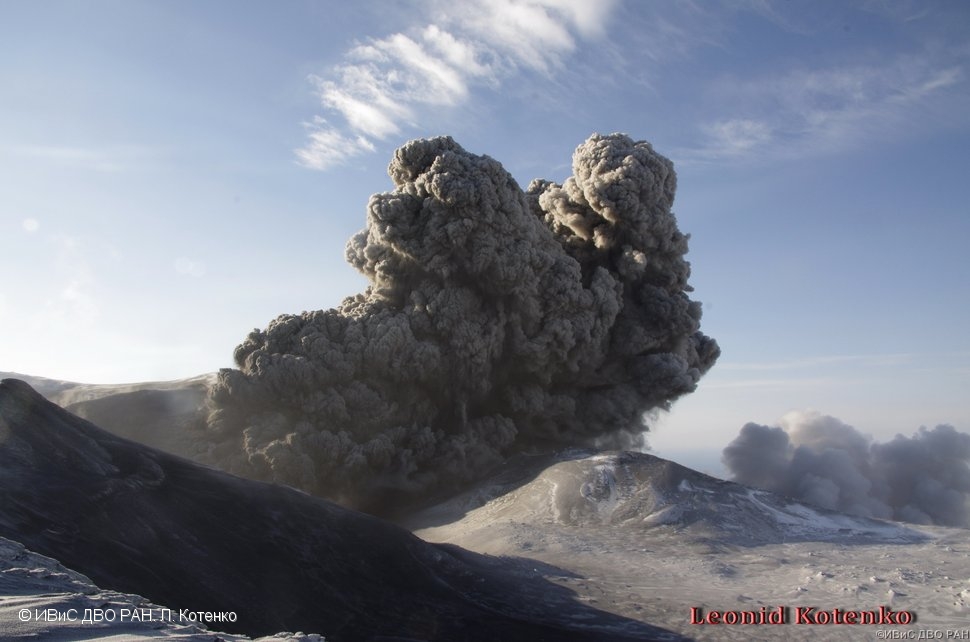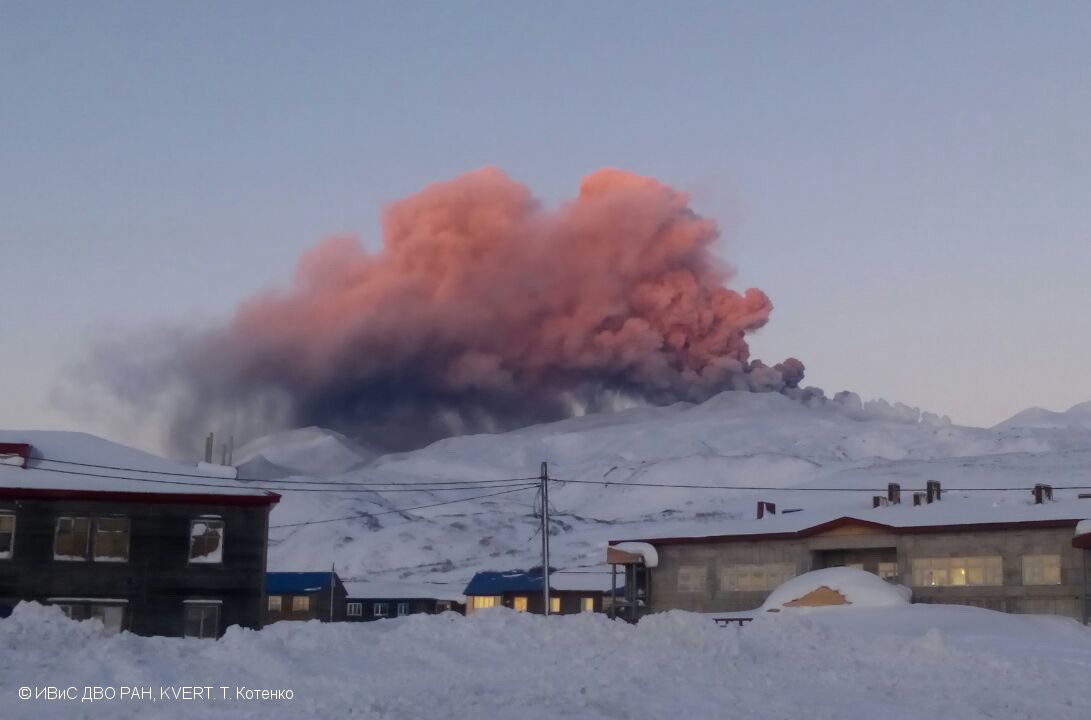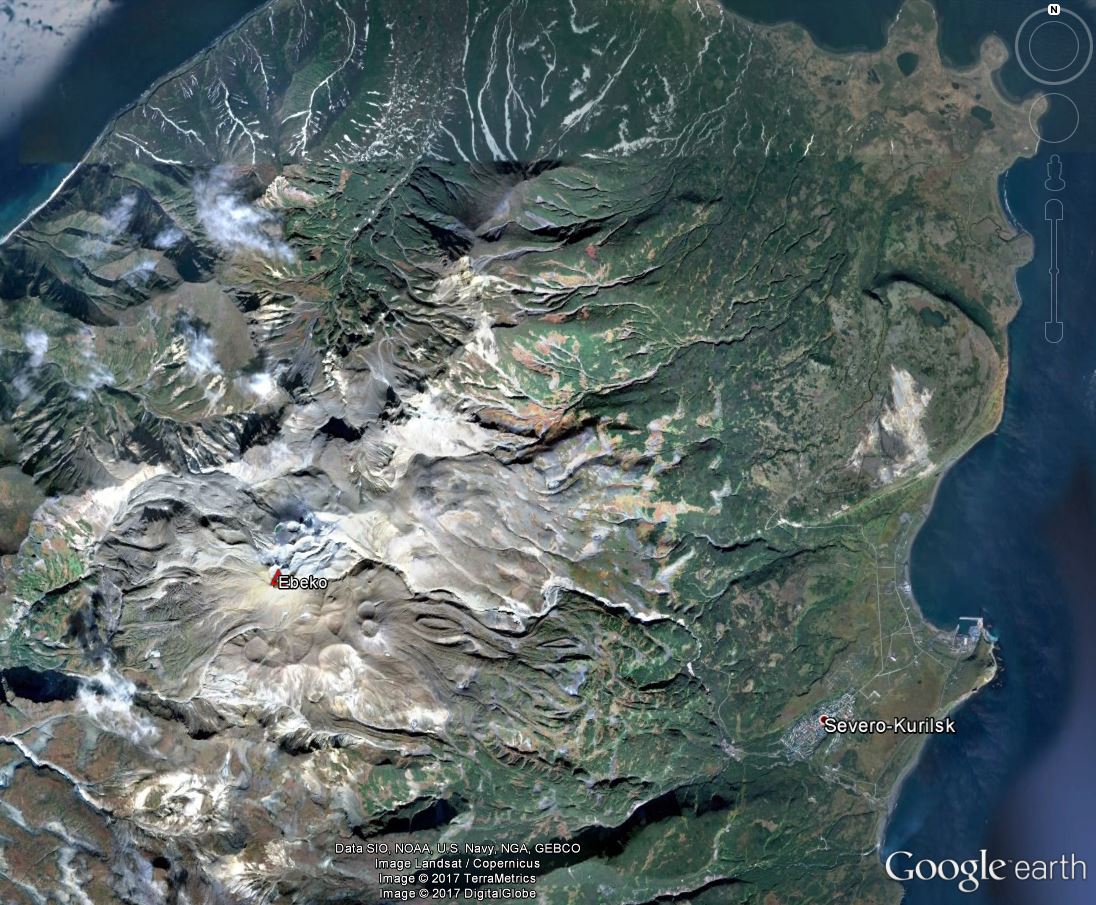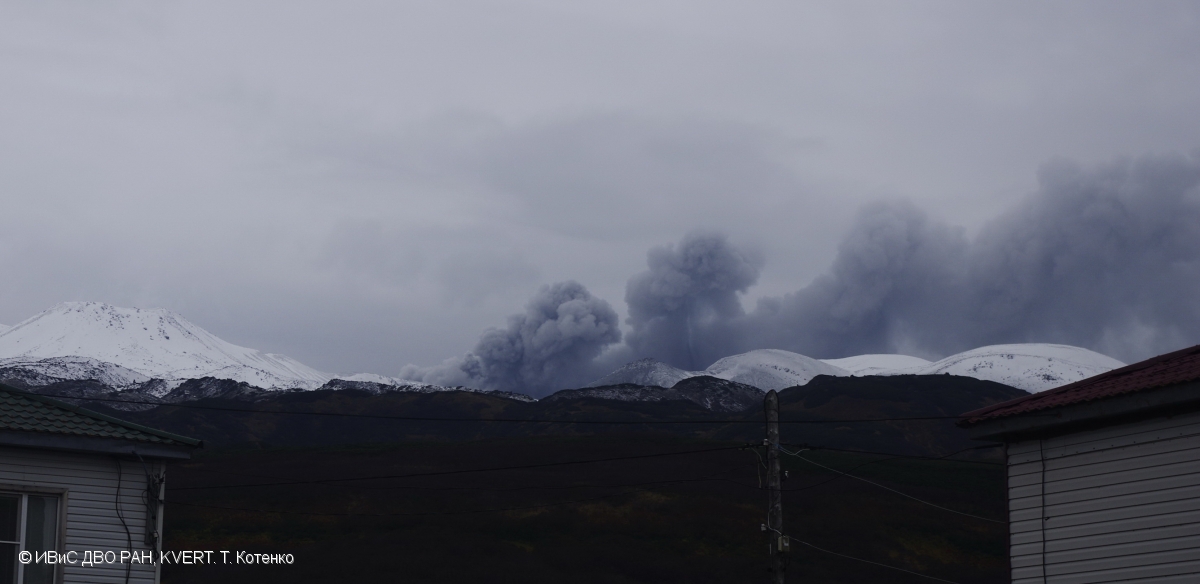Report on Ebeko (Russia) — August 2017
Bulletin of the Global Volcanism Network, vol. 42, no. 8 (August 2017)
Managing Editor: Edward Venzke.
Research and preparation by Robert Andrews.
Ebeko (Russia) New eruption with ash explosions began on 20 October 2016; ongoing through May 2017
Please cite this report as:
Global Volcanism Program, 2017. Report on Ebeko (Russia) (Venzke, E., ed.). Bulletin of the Global Volcanism Network, 42:8. Smithsonian Institution. https://doi.org/10.5479/si.GVP.BGVN201708-290380
Ebeko
Russia
50.686°N, 156.014°E; summit elev. 1103 m
All times are local (unless otherwise noted)
Following explosions that produced ash plumes in early July 2010 (BGVN 36:07), no additional activity was noted from Ebeko by the Kamchatkan Volcanic Eruption Response Team (KVERT) until October 2016. This rather remote volcano on the N end of Paramushir Island in the Kuril Islands (figure 6) contains many craters, lakes, and thermal features (figure 7). Ash plumes were observed on 20 October 2016 and continued to be detected intermittently through 19 April 2017 (table 4).
Table 4. Summary of activity at Ebeko volcano from mid-October 2016 to mid-April 2017. ACC is Aviation Color Code. Data courtesy of KVERT.
| Date | Plume Altitude | Plume Distance | Plume Direction | Other Observations |
| 20 Oct 2016 | 1.5 km; 1.3-1.4 km | 15 km; 10 km | ENE; NE | ACC raised to Yellow. |
| 24 Oct 2016 | -- | -- | -- | ACC lowered to Green. |
| 08-09 Dec 2016 | 1.5 km | 6 km | N | ACC raised to Yellow. |
| 09-10 Dec 2016 | 1.8-1.9 km | 4-5 km | NW | Minor amounts of ash from two vents, in Sredniy Crater (middle) and Severny Crater (northern). |
| 17, 20 Dec 2016 | 1.5 km | 8 km | N, NE | -- |
| 24-27 Dec 2016 | 2-2.5 km | -- | -- | Ash plumes; ACC raised to Orange on 27 Dec. |
| 30 Dec 2016-06 Jan 2017 | -- | -- | -- | Gas and steam plumes, minor ash. |
| 12 Jan 2017 | -- | -- | -- | ACC lowered to Yellow. |
| 19 Jan 2017 | 2 km | 3 km | SW | ACC raised to Orange. |
| 20 Jan-03 Feb 2017 | -- | -- | -- | Minor ashfall in Severo-Kurilsk on 30 Jan. |
| 10 Feb 2017 | -- | -- | -- | Activity declined; ACC lowered to Yellow. |
| 27 Feb 2017 | 2 km | 6 km | N | ACC raised to Orange. |
| 24, 26, 27 Feb 2017; 02 Mar 2017 | up to 2.5 km | -- | -- | Explosions. |
| 03-10 Mar 2017 | 1.6 km | -- | -- | 15 explosions. |
| 20-22 Mar 2017 | 1.7-1.8 km | -- | -- | Several explosions; minor ashfall in Severo-Kurilsk on 21 Mar. |
| 24-31 Mar 2017 | 1.5-3.4 km | -- | -- | Several daily explosions; minor ashfall in Severo-Kurilsk on 26 Mar. |
| 04-06 Apr 2017 | 4 km | -- | -- | Several explosions; minor ashfall in Severo-Kurilsk on 6 Apr. |
| 07-14 Apr 2017 | 2.6 km | -- | -- | Several explosions; minor ashfall in Severo-Kurilsk on 12 Apr. |
| 14, 16, 19 Apr 2017 | 3.2 km | -- | -- | Several explosions; minor ashfall in Severo-Kurilsk on 18 Apr; ACC remained at Orange. |
According to observers about 7 km E in the city of Severo-Kurilsk, a gas-and-steam plume containing a small amount of ash rose from Ebeko on 20 October 2016 (figure 8), marking the start of its most recent eruption. The Aviation Color Code (ACC) was raised from Green to Yellow. Later that day observers noted gas, steam, and ash plumes rising from the volcano. Ground-based and satellite observations during 21-23 October indicated quiet conditions; consequently, the ACC was lowered to Green on 24 October.
On 8-9 December 2016 the ACC was again raised to Yellow when a gas and steam plume containing a small amount of ash was observed. Ash rose from both Sredniy Crater (middle) and Severny Crater (northern) during 9-10 December (figure 9). Further ash plumes were seen during 17-27 December the ACC was raised to Orange. Minor ash was reported during 30 December 2016-6 January 2017, along with gas and steam plumes. An ash plume rose up to 2 km altitude on 19 January (figure 10), and ash fell in Severo-Kurilsk on 30 January. More frequent explosions took place between 24 February and 19 April 2017 (table 4). Simultaneous explosions from two craters was observed on 15 April (figure 11).
 |
Figure 9. Explosive ash eruption from the Ebeko craters at 0116 UTC on 10 December 2016. Photo by L. Kotenko; courtesy of Institute of Volcanology and Seismology FEB RAS, KVERT. |
 |
Figure 10. Ash from an explosive eruption of Ebeko on 19 January 2017 rose up to 2 km altitude. Photo by T. Kotenko; courtesy of Institute of Volcanology and Seismology FEB RAS, KVERT. |
Satellite thermal data from MODVOLC showed no thermal alerts for at least the last 10 years, and MIROVA only identified two low-power anomalies in the past year, one in late February 2017 and the other in late March 2017.
Reference: Rychagov S.N., Belousov V.I., Kotenko ?.A., and Kotenko L.V., 2010, Gas-hydrothermal system of the geothermal deposit, Proceedings World Geothermal Congress 2010 Bali, Indonesia, 25-29 April 2010, 4 p.
Geological Summary. The flat-topped summit of the central cone of Ebeko volcano, one of the most active in the Kuril Islands, occupies the northern end of Paramushir Island. Three summit craters located along a SSW-NNE line form Ebeko volcano proper, at the northern end of a complex of five volcanic cones. Blocky lava flows extend west from Ebeko and SE from the neighboring Nezametnyi cone. The eastern part of the southern crater contains strong solfataras and a large boiling spring. The central crater is filled by a lake about 20 m deep whose shores are lined with steaming solfataras; the northern crater lies across a narrow, low barrier from the central crater and contains a small, cold crescentic lake. Historical activity, recorded since the late-18th century, has been restricted to small-to-moderate explosive eruptions from the summit craters. Intense fumarolic activity occurs in the summit craters, on the outer flanks of the cone, and in lateral explosion craters.
Information Contacts: Kamchatka Volcanic Eruptions Response Team (KVERT), Far Eastern Branch, Russian Academy of Sciences, 9 Piip Blvd., Petropavlovsk-Kamchatsky, 683006, Russia (URL: http://www.kscnet.ru/ivs/kvert/); Institute of Volcanology and Seismology, Far Eastern Branch, Russian Academy of Sciences (IVS FEB RAS), 9 Piip Blvd., Petropavlovsk-Kamchatsky 683006, Russia (URL: http://www.kscnet.ru/ivs/eng/); Hawai'i Institute of Geophysics and Planetology (HIGP) - MODVOLC Thermal Alerts System, School of Ocean and Earth Science and Technology (SOEST), Univ. of Hawai'i, 2525 Correa Road, Honolulu, HI 96822, USA (URL: http://modis.higp.hawaii.edu/); MIROVA (Middle InfraRed Observation of Volcanic Activity), a collaborative project between the Universities of Turin and Florence (Italy) supported by the Centre for Volcanic Risk of the Italian Civil Protection Department (URL: http://www.mirovaweb.it/).





